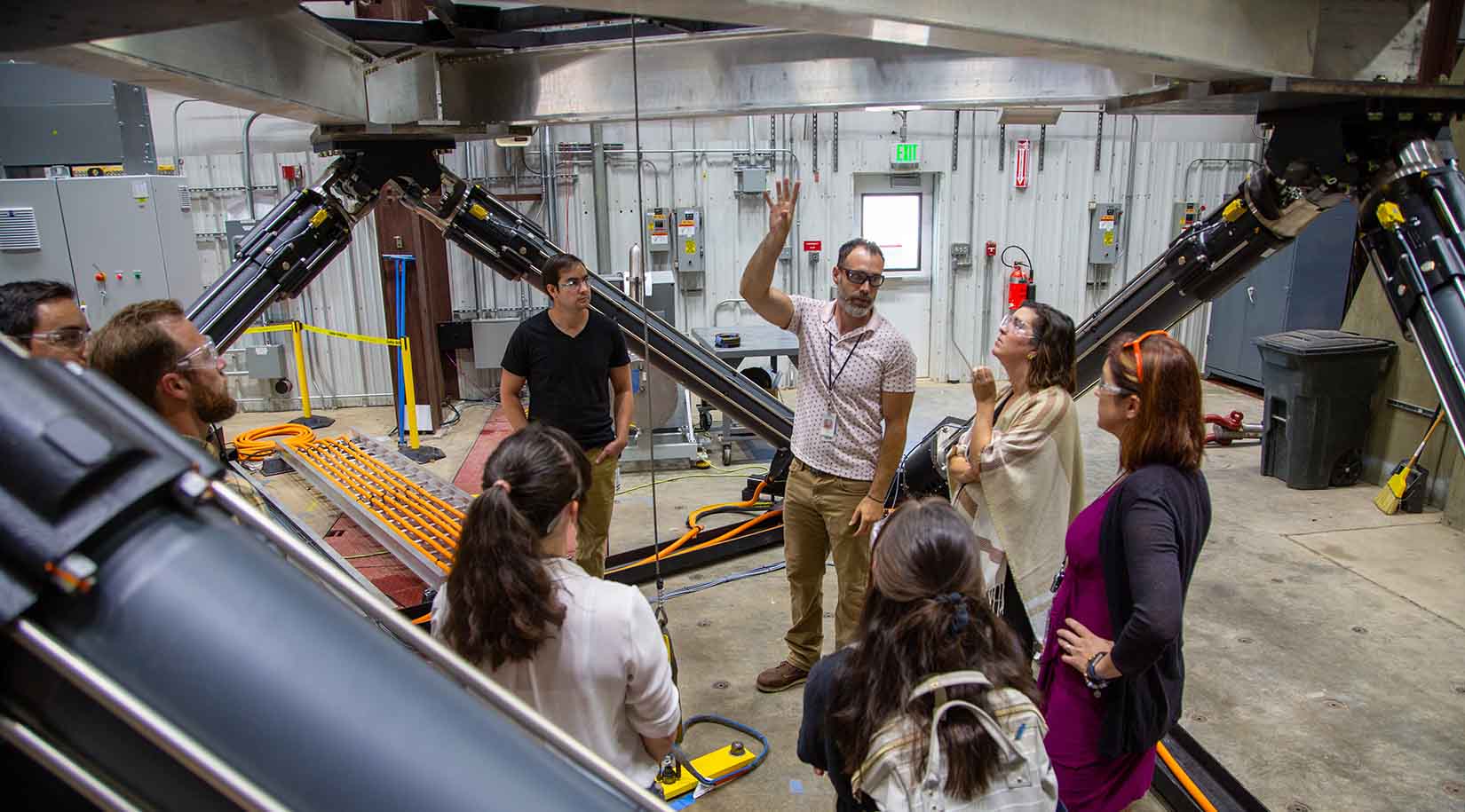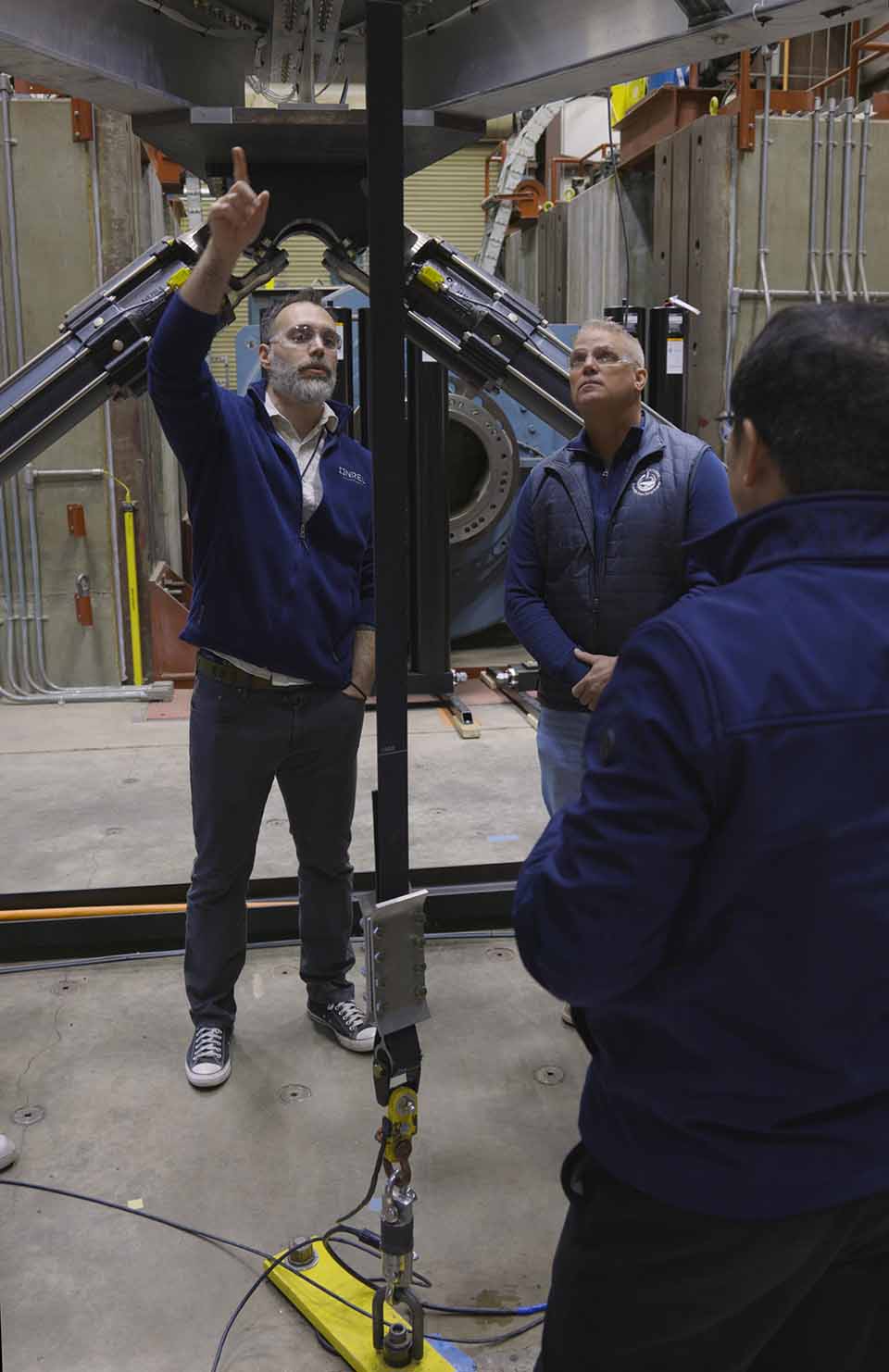HERO’s Mission: An Elevator Part Could Bolster Marine Energy Technologies
Latest HERO WEC Mission Status Update Examines How a Polyurethane Belt Could Improve Reliability of Wave Energy Converters

The HERO WEC's original wire rope runs from the WEC to the floor, where it's anchored beneath the large-amplitude motion platform. Photo by Taylor Mankle, NREL
The National Renewable Energy Laboratory's (NREL's) wave-powered desalination research is charting new waters by improving the robustness, reliability, and deployability of the hydraulic and electric reverse osmosis wave energy converter—or HERO WEC.
To do this, the team will modify different components on the device and test the revised design. Researchers have already started with the winch line, swapping the original wire rope with an upgraded polyurethane flat belt, which overperformed in initial lab testing.
The HERO WEC, which is funded by the U.S. Department of Energy's Water Power Technologies Office (WPTO), can operate using either a hydraulic or an electrical configuration to pump seawater through an onshore reverse osmosis system and produce fresh drinking water (a process called desalination). NREL researchers began designing the HERO WEC in 2020, and after hundreds of hours of testing, which consisted of three in-lab programs and five ocean installations, the team is retiring version one and drawing on lessons learned to design version two.
But why start with the winch system? Because the research team knew it was the HERO WEC's weakest link.
The wire rope used in the original winch system, which ran from the raft-like WEC to an anchor on the seafloor, did serve its intended purpose by acting as a mooring line to prevent the device from drifting while allowing it to move up and down with the motion of the waves. But a wire rope can only take so much force before it wears, frays, and breaks—especially as it moves through pulleys in the harsh ocean environment, where corrosion and storm resistance can be a significant challenge.
That is why the team replaced it with a polyurethane flat belt (something that is typically used for elevator pulleys). These sturdy belts are made of tiny strands of wire rope encased in polyurethane. This configuration helps evenly distribute force, alleviating stress on the belt and allowing it to withstand the large anchor loads. The polyurethane coating, a durable and affordable synthetic material that is also waterproof, helps to mitigate wear and corrosion.

The photo shows the new polyurethane belt that will replace the HERO WEC's original wire rope. Photo by Taylor Mankle, NREL
The team tested the new belt on NREL's large-amplitude motion platform, running it for about 30,000 wave cycles (approximately how many wave cycles it would face during a typical two- to four-day ocean deployment). Even after thousands of test cycles, the belt still showed no visible signs of wear, indicating a much longer lifespan. Based on the team's models and motion platform data, the team predicts that this type of belt should last one or two years in the ocean before needing to be replaced.
Researchers also tested the belt under a range of stressful (simulated) ocean conditions, pushing the belt to see if it would slip, fold, or wind/unwind faster than it should. They found that the belt showed no sign of slippage or tangling, confirming that the belt is a promising upgrade to the HERO WEC's design. Because of its durability, a belt like this could significantly enhance reliability, allow for longer deployments, reduce maintenance, and ultimately increase freshwater production.
If the polyurethane belt performs well during ocean testing, these preliminary research findings will not only prove promising for NREL's wave-powered desalination research but also advance the reliability of marine energy technologies across the board. Results from the HERO WEC belt testing are available to other researchers and developers. These initial findings could serve as a stepping stone for marine energy developers looking to both de-risk and enhance their existing WEC designs.
Because the belt has proven to be so robust, the research team is using it as a cornerstone for designing HERO WEC V2. Building on this durable winch system, researchers will now focus on other HERO WEC components to further improve its reliability.
Stay tuned for more HERO WEC design updates, test results, and project milestones.
Learn more about NREL's research in marine energy and the HERO WEC device and its open-source data. Then, subscribe to The Current—NREL's water power newsletter—to stay up to date on the latest research.
Last Updated May 28, 2025
